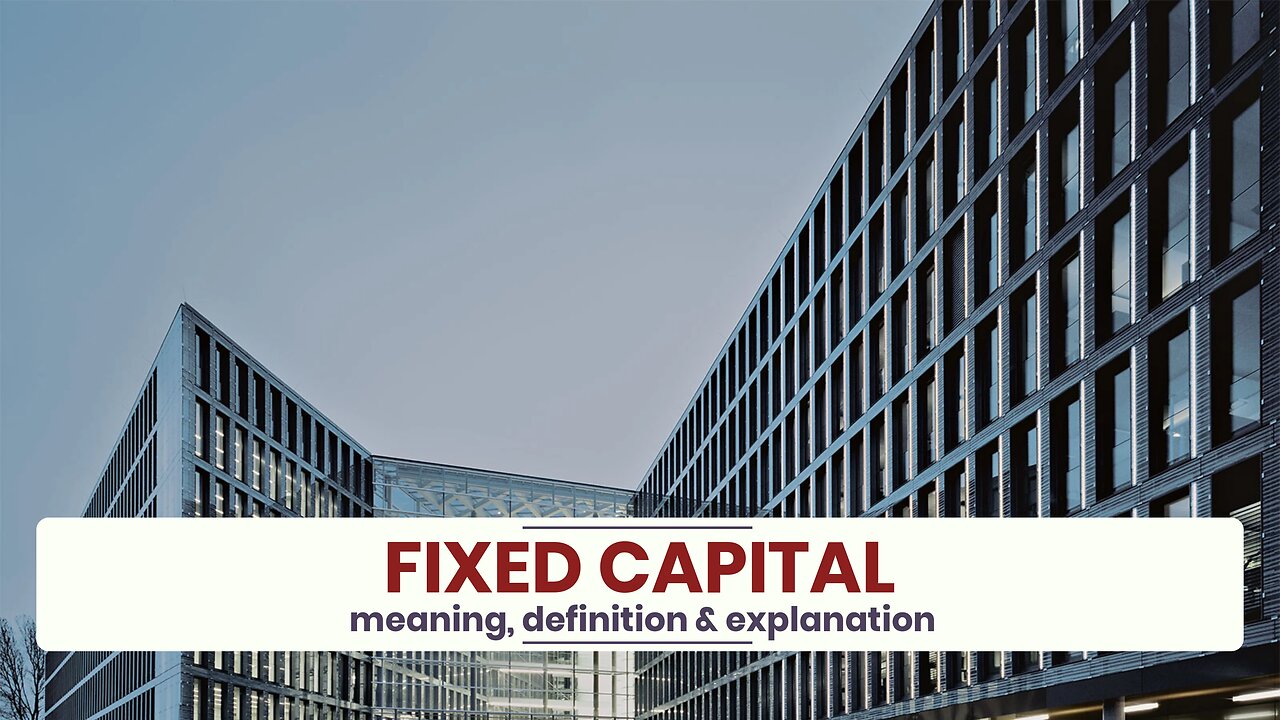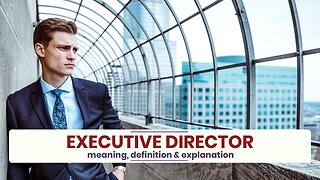Premium Only Content

What is FIXED CAPITAL?
✪✪✪✪✪
http://www.theaudiopedia.com
✪✪✪✪✪
What does FIXED CAPITAL mean? FIXED CAPITAL meaning - FIXED CAPITAL definition - FIXED CAPITAL explanation. What is the meaning of FIXED CAPITAL? What is the definition of FIXED CAPITAL? What does FIXED CAPITAL stand for? What is FIXED CAPITAL meaning? What is FIXED CAPITAL definition?
Fixed capital is a concept in economics and accounting, first theoretically analyzed in some depth by the economist David Ricardo. It refers to any kind of real or physical capital (fixed asset) that is not used up in the production of a product. It contrasts with circulating capital such as raw materials, operating expenses and the like.
So fixed capital is that portion of the total capital outlay that is invested in fixed assets (such as land, buildings, vehicles, plant and equipment), that stay in the business almost permanently - or at the very least, for more than one accounting period. Fixed assets can be purchased by a business, in which case the business owns them. They can also be leased, hired or rented, if that is cheaper or more convenient, or if owning the fixed asset is practically impossible (for legal or technical reasons).
Refining the classical distinction between fixed and circulating capital in Das Kapital, Karl Marx emphasizes that the distinction is really purely relative, i.e. it refers only to the comparative rotation speeds (turnover time) of different types of physical capital assets. Fixed capital also "circulates", except that the circulation time is much longer, because a fixed asset may be held for 5, 10 or 20 years before it has yielded its value and is discarded for its salvage value. A fixed asset may also be resold and re-used, which often happens with vehicles and planes.
In national accounts, fixed capital is conventionally defined as the stock of tangible, durable fixed assets owned or used by resident enterprises for more than one year. This includes plant, machinery, vehicles and equipment, installations and physical infrastructures, the value of land improvements, and buildings.
The European system of national and regional accounts (ESA95) explicitly includes produced intangible assets (e.g. mineral exploitation, computer software, copyright protected entertainment, literary and artistics originals) within the definition of fixed assets.
Land itself is not included in the statistical concept of fixed capital, even though it is a fixed asset. The main reason is that land is not regarded as a product (a reproducible good). But the value of land improvements is included in the statistical concept of fixed capital, being regarded as the creation of value-added through production.
Attempts have been made to estimate the value of the stock of fixed capital for the whole economy using direct enterprise surveys of "book value", administrative business records, tax assessments, and data on gross fixed capital formation, price inflation and depreciation schedules. A pioneer in this area was the economist Simon Kuznets.
The so-called "perpetual inventory method" (PIM) used to estimate fixed capital stocks was invented by Raymond W. Goldsmith in 1951 and subsequently used around the world. The basic idea of the PIM method is, that one starts off from a benchmark asset figure, and adds on the net additions to fixed assets year by year (using gross fixed capital formation data), while deducting annual depreciation, all data being adjusted for price inflation using a capital expenditure price index. In this way, one obtains a time series of annual fixed capital stocks. This data series can also be modified further with various other adjustments for prices, asset lifetimes etc. (several variants of the PIM approach are nowadays used by economic historians and statisticians).
-
 1:52
1:52
The Audiopedia
10 months agoWhat is EXECUTIVE DIRECTOR?
531 -
 LIVE
LIVE
vivafrei
11 hours agoEp. 261: Criminal Judges ARRESTED! Election in Canada! Santos Sentenced! RFK Jr. & Autism & MORE!
31,254 watching -
 LIVE
LIVE
TheSaltyCracker
1 hour agoThey Killed Her ReeEEEe Stream 04-27-25
16,009 watching -
 DVR
DVR
Nerdrotic
3 hours ago $2.82 earnedDiscoveries From Graham Hancock's "Fight for the Past" | Forbidden Frontier 099
12.2K4 -
 1:09:42
1:09:42
Sarah Westall
2 hours agoHidden Tech Resembles Star Trek: Malaysian Airline, Portals & Wormholes w/ Ashton Forbes
2.77K3 -
 DVR
DVR
Josh Pate's College Football Show
2 hours ago $0.01 earnedCFB Truth About NFL Draft | Sheduer & Ewers Slide | James Franklin vs Fans | 2025’s Biggest What-Ifs
471 -
 LIVE
LIVE
Due Dissidence
10 hours agoTrump's Polling COLLAPSES, WI Judge ARRESTED, Biden DRAGGED at WHCD, Corporations PULL Pride Funding
1,496 watching -
 LIVE
LIVE
EricJohnPizzaArtist
1 hour agoAwesome Sauce PIZZA ART LIVE Ep. #45: Tony the Cat!
118 watching -
 LIVE
LIVE
OhHiMark1776
3 hours ago🟢04-27-25 ||||| Halo Multiplayer Rumble: No. 13 ||||| Halo MCC (2019)
148 watching -
 15:05
15:05
Stephen Gardner
1 day ago🔥BREAKING: Trump HAMMERS Zelensky after Kicking France's Macron from meeting about Ukraine!
83.8K323